Concepts on Microarray Design for Genome and Transcriptome Analyses
Microarray technology has revolutionized molecular biology by permitting many hybridization experiments to be performed in parallel. With the size of a glass microscope slide, this tool can carry thousands of DNA fragments in an area smaller than a postage stamp. In this chapter, we will describe microarray chips that host nucleic acid probes, which are the most commonly used type of microarrays. Science in this field is mostly data-driven, where biological hypothesis are generated upon analysis and comparison of a huge amount of potentially meaningful differential data derived from microarray hybridizations. DNA microarray technology is under a constant and rapid evolution. The first paper reporting DNA microarray as a tool for transcript-level analyses has been published in 1995, and that chip had about 1000 Arabidopsis genes. Almost 11 years have passed and advances in miniaturization, robotic, and informatics, as well as the development of alternative approaches to microarray construction have permitted to put more than 250,000 different spots into a single square centimeter. This rapid advance in the microarray field, combined with the falling price of technology and the acquisition of wholegenome sequence information for hundreds of organisms has caused biologists to abandon their home-made equipment in favor of one of an expanding range of commercial platforms now available on the market. However, we are still not able to represent the entire genome of any eukaryotic organism in a unique chip or even to analyze the great complexity of the human transcriptome. Therefore, how to choose and design the best probes to construct DNA microarray chips is a crucial step to the appropriate use of this powerful technique (Figure 1).
Authors
Helder I. Nakaya; Eduardo M. Reis; Sergio Verjovski-Almeida
External link
Publication Year
Publication Journal
Associeted Project
Life Sciences
Lista de serviços
-
Gene regulatory and signaling networks exhibit distinct topological distributions of motifs.Gene regulatory and signaling networks exhibit distinct topological distributions of motifs.
-
Gene signatures of autopsy lungs from obese patients with COVID-19.Gene signatures of autopsy lungs from obese patients with COVID-19.
-
Network Medicine: Methods and ApplicationsNetwork Medicine: Methods and Applications
-
ACE2 Expression Is Increased in the Lungs of Patients With Comorbidities Associated With Severe COVID-19.ACE2 Expression Is Increased in the Lungs of Patients With Comorbidities Associated With Severe COVID-19.
-
Drug repositioning for psychiatric and neurological disorders through a network medicine approach.Drug repositioning for psychiatric and neurological disorders through a network medicine approach.
-
Linking proteomic alterations in schizophrenia hippocampus to NMDAr hypofunction in human neurons and oligodendrocytes.Linking proteomic alterations in schizophrenia hippocampus to NMDAr hypofunction in human neurons and oligodendrocytes.
-
In-depth analysis of laboratory parameters reveals the interplay between sex, age, and systemic inflammation in individuals with COVID-19.In-depth analysis of laboratory parameters reveals the interplay between sex, age, and systemic inflammation in individuals with COVID-19.
-
The evolution of knowledge on genes associated with human diseasesThe evolution of knowledge on genes associated with human diseases
-
Network vaccinology.Network vaccinology.
-
Pyruvate kinase M2 mediates IL-17 signaling in keratinocytes driving psoriatic skin inflammationPyruvate kinase M2 mediates IL-17 signaling in keratinocytes driving psoriatic skin inflammation
-
Transcriptome analysis of six tissues obtained post-mortem from sepsis patientsTranscriptome analysis of six tissues obtained post-mortem from sepsis patients
-
Gene Signatures of Symptomatic and Asymptomatic Clinical-Immunological Profiles of Human Infection by Leishmania (L.) chagasi in Amazonian BrazilGene Signatures of Symptomatic and Asymptomatic Clinical-Immunological Profiles of Human Infection by Leishmania (L.) chagasi in Amazonian Brazil
-
In vitro morphological profiling of T cells predicts clinical response to natalizumab therapy in patients with multiple sclerosis.In vitro morphological profiling of T cells predicts clinical response to natalizumab therapy in patients with multiple sclerosis.
-
Integrative immunology identified interferome signatures in uveitis and systemic disease-associated uveitis.Integrative immunology identified interferome signatures in uveitis and systemic disease-associated uveitis.
-
Gene regulatory networks analysis for the discovery of prognostic genes in gliomas.Gene regulatory networks analysis for the discovery of prognostic genes in gliomas.
-
Revealing shared molecular drivers of brain metastases from distinct primary tumors.Revealing shared molecular drivers of brain metastases from distinct primary tumors.

